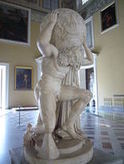Upper Cervical Misalignment
Though upper cervical is located at the tip of the upper neck, its misalignment directly interferes with how the brain controls the body.
What is upper cervical?

Atlas: Lalupa, Wikimedia Commons
The cervical spine is made up of 7 neck bones. A portion of the base of skull together with the first and second cervical vertebrae form the region called the upper cervical. The first cervical vertebra is the key player in this link, as it provides support for the skull, movement of the head and protection to the brainstem which is encased inside.
In Greek Mythology, Atlas supports the heaven with his shoulders. In the body, the atlas is the first cervical vertebra. It is so named because this tiny bone supports the massive weight of the head.
Embedded in the skull are the paired inner ears and eyes. Through these organs, the brain precisely detects the vertical and horizontal coordinates of the head.


anatomical animations: BodyParts3D / Anatomography, Wikimedia Commons
What is upper cervical misalignment?
Upper cervical misalignment (a.k.a. Atlas Subluxation or C1 subluxation, Upper Cervical Subluxation) means the atlas (C1) is not in perfect alignment with the skull. With the malposition of atlas, the signals generated from the sensors in the joints and muscles on one side of the upper neck does not reflect the actual position of the head. Thus, the signals gathered from the eyes and the ears will be erred, and causes asymmetry of the muscle tone of the body. Subsequently, it causes discomfort.
How does upper cervical misalignment affect the body?
For more than half a century, chiropractors have observed that upper cervical misalignment disturbs the normal function of the nervous system, causing:
- postural problems, and aches and pains anywhere in the body (refer to "Cause of common pains"),
- functional problems of the viscera, making it more susceptible to diseases.
"Better than 90 percent of the energy output of the brain is used in relating to the physical body in its gravitational field. The more mechanically distorted a person is, the less energy available for thinking, metabolism and healing."

Upper cervical normal

Normal body frame

Upper cervical misalignment

Distorted body frame
In an unbalanced structure, many joints are stressed, muscles strained and bones misaligned. With prolonged mechanical stress,the patient may feel achy at times. Occasionally he/she may experience pain localized at the vicinity of the area of irritation, or radiating away from it.
As the upper neck usually does not show any noticeable symptoms at all, the attention of the clinician and the patient alike is unavoidably drawn to the consequence. Unfortunately, applying treatment without attending the cause leads to frequent recurrence of the condition and bring forth other new conditions.
Causes of upper cervical misalignment
The head and neck can be knocked off-balance in many different ways:
- abnormal presentation
- birth trauma - the use of forceps, suction and c-section
- childhood falls
- roller coaster rides
- athletic injuries
- accidents and injuries
- falls on an icy surface
- keeping abnormal posture for an extended period of time
In addition to positional deviation and joint dysfunction, the asymmetry of muscle tone and body imbalance are essential criteria for the diagnosis of upper cervical misalignment.

